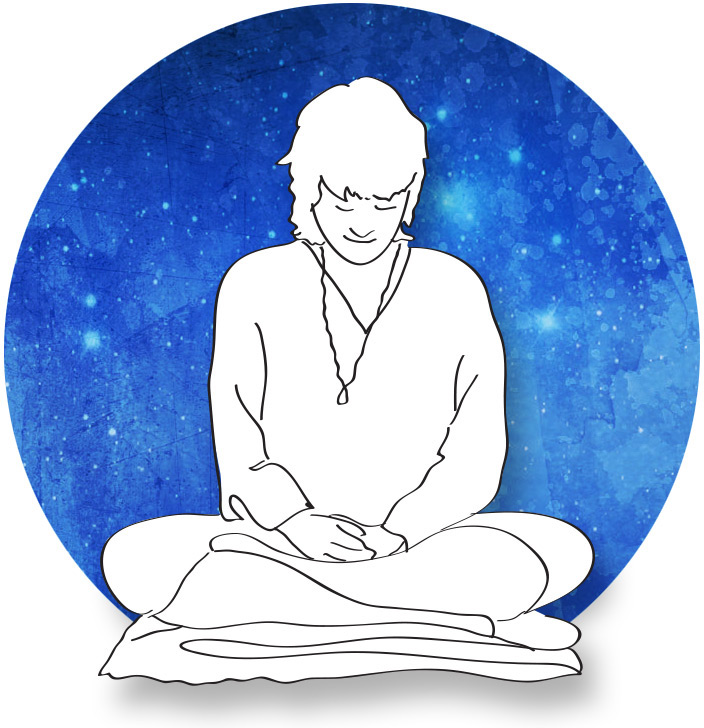by Mary Reilly Nichols

I was speaking about non-dual awareness with a friend when she rightly pointed out that the phrase ‘non-dual’ itself is dualist. That is why i like the term samadhi to describe the non-dual state. The word samadhi derives from the Indo-European root, sam, which is also the source of the English word ‘same’. It connotes unity, evenness, equality. Samadhi, the perception of oneness, is the true bread of life. The visceral experience of union we get from yoga practices is a delicious recharge of the nervous system.
It is fair to say that the purpose of Hatha Yoga is to prepare the neural system for samadhi by stimulating it perfectly equably and by priming it with oxygen. Whether we know it or not, the refreshing tranquility obtained from a yoga class is a taste of samadhi. As the Shiva Sutras comment,
Pranasamachare samadarshanam (3:24)
Evenness of prana brings samadhi
What’s more, the symmetry of asana balances the right/left activity of the brain, making it amenable to the peaceful ecstasy of oneness. The postures make the spinal axis of the body vividly implicit, creating a sensory focus for the place where our physical halves unite. When I breathe with awareness up and down that interior centering path, I call it “walking the line.” On a more subtle level, walking the line stands for the discipline of attention along the singular fine axis of the sushumna, the central spinal channel also called the madhyanadi, where the amrit — the nectar — of unity is perpetually flowing.
It says in the Vijnana Bhairava Tantra:
Madhyanadi madhyasamstha bisasutrabharupataya
Dhyatanlarvyomaya devya taya devah prakasate (Dharana 12)
The central channel is situated in the middle, as slender as a lotus stalk.
If one meditates on the inner vacuity of this nadi, the Divine is revealed.
This strict adherence to interior axial attention gives a physical cue to the moderation and detachment from extremes designated by Buddha as the ‘middle path’, the Madhyamāpratipad.
In Taoism, the yin-yang symbol presents a flowing line formed between the dark and light halves. The graceful Taoist “way” is an “s” curve, like the spine. The serpent shaped black and white yin and yang are analogous to the ida and pingala of yoga. The border line where these opposites unite forms the shimmering communion between self and cosmos, the rapture of the precise locus where two become one. That line is the perfect intersection of the known and the unknown, the personal and the universal, the finite and the infinite. Right at the place of meeting there is maximum bliss. Yoga becomes a passionate surrender going on between oneself and the cosmos, through the breath rising and falling along the spine.
We should understand that samadhi is not an exotic state attained only by rare dedicated practitioners. In fact, Patanjali himself described different levels of samadhi, from the more ordinary to the transcendent.
Even though we haven’t had a word for it, samadhi is the felt-sense of our essential nature, a constant substrate layer of consciousness at the core of our being. It is already attained. Our work is becoming mentally subtle enough to recognize it. So yoga practice is about refining perception to reveal the treasure that is already there.
It’s good not to approach yoga endeavors with too much seriousness. I love to joke with Cosmic Consciousness, which has an amazing sense of humor. Sometimes when running around doing the needful, I maintain breath awareness along my inner core and mentally offer to the Divine this mantric sloka from the sage, Johnny Cash:
I keep a close watch on this heart of mine
I keep my eyes wide open all the time
I keep the ends out for the tie that binds
Because You’re mine, I walk the line
Because You’re mine, I walk the line
Because You’re mine, I walk the line
Editor’s note: Mary Reilly Nichols is the Director of Nalanda Institute’s Yoga, Mind & Spirit training program. She will be teaching a four-week online course with Embodied Philosophy (begins November 13), entitled I Am That: The Pervasive Nectar of Non-Duality. This post first appeared in Voices, Embodied Philosophy’s free weekly newsletter and is reprinted with their kind permission.
Mary will also be teaching in Nalanda Institute’s Yoga, Mind & Spirit training program beginning January 18. Find out more on our information page.
She also leads the very popular and inspiring Nalanda Institute Thursday Lunchtime Meditations at Tibet House.
Illustration of Mary Reilly Nichols by Lotus + Pixel
